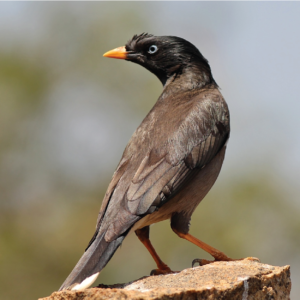Jungle Myna

- Distribution: Found in South and Southeast Asia, including India, Bangladesh, Myanmar, Thailand, and parts of Southeast Asia.
- Habitat: Tropical and subtropical forests, open woodlands, gardens, and urban areas.
- Diet: Omnivorous, feeding on insects, fruits, seeds, and occasionally small vertebrates.
- Size: Approximately 23-26 cm in length.
One kind of myna that belongs to the starling family is the jungle myna (Acridotheres fuscus). It is absent in India’s dry regions yet found sporadically throughout the Indian Subcontinent’s mainland. Depending on the population, the eyes might be pale, yellow, or blue, and the orange-yellow bill’s base is dark.
The gray plumage of jungle mynas, which are 9.1 inches (23 centimeters) long, is darker on the head and wings. The plumage of the sexes is identical. When in flight, the broad white tips on the tail feathers stand out, as do the big white wing patches on the base of the primaries. At the base of the bill, there is a tuft of feathers on the forehead.
Unlike the common and bank mynas, which have naked skin around the eyes, the beak and legs of this species have a vivid yellow color.
Compared to the common myna, the jungle myna has higher-pitched sounds. Foraging flocks ask for contact with clipped cheeping sounds.
The jungle myna is a common resident breeder that comes from Bangladesh, India, and Nepal in tropical southern Asia. Northern India is home to subspecies fuscus, which extends from Mount Abu in the west to Puri in Orissa in the east. In addition, it was brought to Fiji and the Andaman Islands in the 1890s to manage insect infestations in sugarcane.
As omnivores, jungle mynas mostly consume fruit, seeds, and insects. They typically forage on the ground with other myna species. Additionally, they steal berries on low-lying shrubs like Lantana, nectar from big blooms on trees like Erythrina (which they may also pollinate by using their tuft feathers as brushes), and water gathered in the blossoms of exotic plants like Spathodea campanulata.
